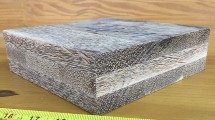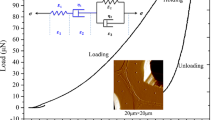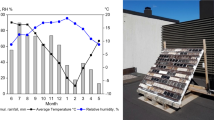Abstract
The deterioration of coconut leaf thatch, a cheap roofing material, has been studied by following the changes in strength on its exposure to both natural and accelerated environmental conditions such as natural weathering, accelerated conditions of rain and alternate wet and dry climate and micro-organisms such as fungus. Strength was found to decrease with time during deterioration. Scanning electron and stereo-optical microscopes were also used to study the fracture phenomena and surface changes during deterioration. It has been found that the major factors contributing to the deterioration of coconut leaf thatch are identified as rain, alternate wet and dry weather, decay by fungus and the brittle nature of the leaf itself. It appears from the present study that the deterioration of coconut leaf thatch occurs as a result of progressive embrittlement with possible contributions from environmental stress-cracking.
Similar content being viewed by others
References
C. K. S. Pillai andP. K. Rohatgi,J. Sci. Ind. Res. 40 (1981) 363.
Rama Varma,Ind. Coconut J. 11 (1957) 29.
A. Purushotham andK. S. Rana,Ind. Forestery 79(4) (1953) 243.
G. M. Hunt andG. A. Garratt, “Wood Preservation” (McGraw-Hill, New York, 1964).
D. W. Lovelock andR. J. Bilbert (Eds), “Microbial Aspects of the Deterioration of Materials” (Academic Press, London, 1975).
James P. Casey, “Pulp and Paper Chemistry and Chemical Technology”, 2nd edn., Vol.I (Interscience, New York, 1960) p. 89.
O. H. Wyatt andD. Dew-Hughes, “Metals, Ceramics and Polymers” (Cambridge University Press, 1974).
K. P. V. Menon andK. M. Pandalai, “The Coconut Palm: A Monograph” (Indian Central Coconut Committee, Ernakulam, 1960).
H. P. Brown, A. J. Pashin andC. C. Forsaith, “Text Book of Wood Technology”, Vol. II (McGraw-Hill, New York, 1962).
G. S. Ergeton,Text. Res. J. 13 (1948) 659.
T. S. A. Padmanabhan andL. R. Sud, “Cellulose Research Symposium”, Vol. 1 (Council of Scientific and Industrial Research, New Delhi, 1958) p. 19.
B. L. Browning (Ed.), “The Chemistry of Wood” (Interscience, London, 1963).
E. Ott, H. M. Spurlin andN. W. Grafflin, “Cellulose and Cellulose Derivatives”, Part I (Interscience, New York, 1954).
Edward J. Kramer, Environmental cracking of polymers in “Developments in Polymer Fracture”, Vol. 1, edited by E. H. Andrews (Applied Science, London, 1979).
R. P. Kambour, “Mechanisms of Environment Sensitive Cracking of Materials” edited by P. R. Swan, F. P. Fordand and A. R. C. Westwood (Metals Society, London, 1977).
Author information
Authors and Affiliations
Rights and permissions
About this article
Cite this article
Pillai, C.K.S., Venkataswamy, M.A., Satyanarayana, K.G. et al. A mechanical study of the deterioration of coconut leaf thatch under natural and accelerated environmental conditions. J Mater Sci 17, 2861–2868 (1982). https://doi.org/10.1007/BF00644663
Received:
Accepted:
Issue Date:
DOI: https://doi.org/10.1007/BF00644663




